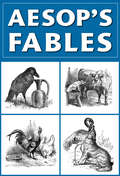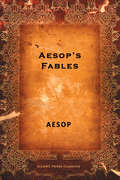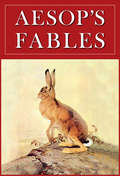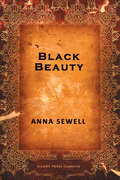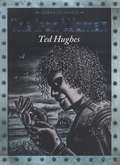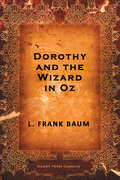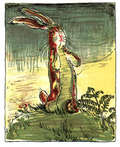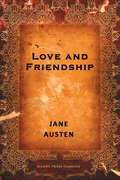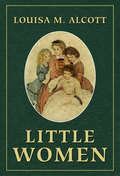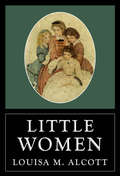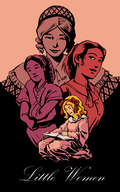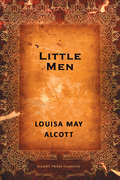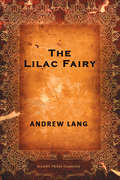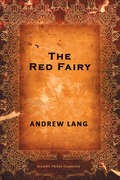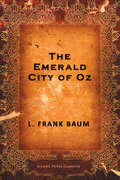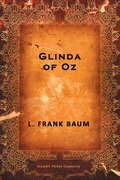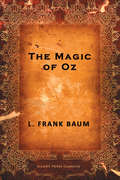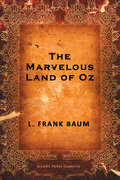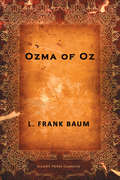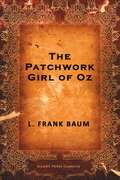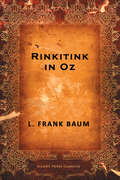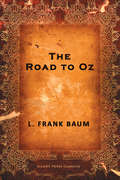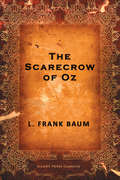- Table View
- List View
Aesop's Fables
by AesopIt is believed that Aesop was a slave who lived in ancient Greece between 620 and 560 B.C. This illustrated collection contains 110 of his celebrated fables.
Aesop's Fables
by Aesop V. S. Vernon Jones Arthur RackhamAesop's Fables is a collection of instructive short stories, typically ending with a moral lesson. Some fables, such as "The Fox and the Crow" or "The North Wind and the Sun", have been popular for centuries.
Aesop's Fables
by AesopIt is believed that Aesop was a slave who lived in ancient Greece between 620 and 560 B.C. This illustrated collection contains 110 of his celebrated fables.
Black Beauty
by Anna SewellBlack Beauty is one of the best-selling novels ever published and takes its title from the horse who narrates the story. Black Beauty begins his young life in the English countryside and eventually becomes a cab horse in London. After many moves and changes, he retires back in his beloved green pastures, where he reflects on the treatment he received, both good and bad, by his owners and handlers. The only book by English author Anna Sewell, Black Beauty was meant to call for humane and ethical treatment of animals, particularly horses, with which Sewell shared a special bond throughout her life. First published in 1877, Black Beauty has been adapted multiple times for film and television.
The Iron Woman (PDF)
by Ted Hughes Andrew DavidsonMankind for has polluted the seas, lakes and rivers. The Iron Woman has come to take revenge. Lucy understands the Iron Woman's rage and she too wants to save the water creatures from their painful deaths. But she also wants to save her town from total destruction. She needs help. Who better to call on but Hogarth and the Iron Man . . . ' A sequel and companion volume to Ted Hughes' The Iron Man, this new, child-friendly setting will be treasured by a new generation of readers.
The Iron Woman
by Ted Hughes Andrew DavidsonMankind for has polluted the seas, lakes and rivers. The Iron Woman has come to take revenge. Lucy understands the Iron Woman's rage and she too wants to save the water creatures from their painful deaths. But she also wants to save her town from total destruction. She needs help. Who better to call on but Hogarth and the Iron Man . . . ' A sequel and companion volume to Ted Hughes' The Iron Man, this new, child-friendly setting will be treasured by a new generation of readers.
Dorothy and the Wizard in Oz
by L. Frank BaumPublished in 1908, this is the story of Dorothy, her cat Eureka, her cousin Zeb, and his horse Jim and how they get swallowed up by an earthquake and end up in Oz where they meet the Wizard again.
The Velveteen Rabbit (or How Toys Become Real)
by Margery Williams William NicholsonOriginally published in 1922, The Velveteen Rabbit has delighted young readers for nearly a century. The story follows a young boy who’s given a stuffed rabbit as a Christmas gift. After the rabbit befriends other nursery toys, he comes to the realization that he wants to become a real rabbit. Eventually, the boy becomes ill and is relocated; his room is then disinfected and all the boy’s toys are thrown out, including the velveteen rabbit. The rabbit sheds a real tear causing a fairy to appear and turn him into a real rabbit. This edition includes full-color illustrations, with image descriptions,from the original illustrator, William Nicholson. Each image accompanies the text to enhance young readers’ experience and immerse them in this captivating story. Reprinted hundreds of times since its initial publication, The Velveteen Rabbit is a timeless children’s classic lets young readers experience the true magic of friendship, love, and being honest with oneself. In 2007, the book was named one of "Teachers’ Top 100 Books for Children” by the National Education Association.
Love and Friendship and other Early Works
by Jane AustenThis collection of short works was written when Jane Austen was in her early teens. It includes the story "Love and Friendship" which is written as letters from the heroine Laura to Marianne, the daughter of her friend Isabel. In all the stories it's easy to see Austen's cutting wit and take on romance that became so characteristic of her writing later on. This collection also includes a preface by G.K. Chesterton. The works included are : Love and Friendship, Lesley Castle, The History of England, Collection of Letters, Scraps.
Little Women
by Louisa May AlcottBeloved classic Little Women is about the March sisters—Meg, Jo, Beth and Amy—and their childhood and teenage years in Massachusetts during the Civil War. They live with their Mother, Marmee, and are close with their neighbours, especially the young man next door, Laurie. Through various struggles, experiences, and romances the girls or "little women" learn who they are and grow into adults. Written in 1868, Little Women was followed by two sequels, Little Men and Jo's Boys. All of these books have found their way into popular culture through film, television and stage adaptaptions, but it is Little Women that remains the most popular.
Little Women
by Louisa May AlcottLittle Women is an autobiographical account of the author and her three sisters growing up during the Civil War in Concord, Massachusetts. These were the happiest years of their lives even though they faced the constant threat of poverty. The girls made use of a neighbouring barn to produce plays written by Louisa May. Little Women was written in 1869 and sales of it and her other books helped to make life less of a struggle for her parents in their later years.Sayre Street Books offers the world's greatest literature in easy to navigate, beautifully designed digital editions.
Little Women
by Louisa May AlcottBeloved classic Little Women is about the March sisters—Meg, Jo, Beth and Amy—and their childhood and teenage years in Massachusetts during the Civil War. They live with their Mother, Marmee, and are close with their neighbours, especially the young man next door, Laurie. Through various struggles, experiences, and romances the girls or "little women" learn who they are and grow into adults. Written in 1868, Little Women was followed by two sequels, Little Men and Jo's Boys. All of these books have found their way into popular culture through film, television and stage adaptaptions, but it is Little Women that remains the most popular.
Little Men
by Louisa May AlcottConsidered the unofficial sequel to Little Women, Little Men is about a now adult and married Jo March and the boy's school she runs with her husband, Professor Bhaer. Plumfield is not a traditional school of the time—some of children run their own little businesses. They are also allowed to have pets and gardens, and there's even a scheduled pillow fight time. The story begins with the arrival of new student Nat Blake, and it is from his perspective that we see the other characters. Mischief, friendship, and learning abound in Plumfield as the boys are molded into little men.
The Lilac Fairy
by Andrew LangThe last of Andrew Lang's twelve famous Fairy Books, The Lilac Fairy Book features thirty-three stories from all over the world, including Portuguese, Scottish, Norwegian, and Swahili fairy tales, amongst many others. Lang's collections are notable for their graphic and often violent story elements, as well as for the beautiful original plates that are included as illustrations. His Fairy Books have been cited as literary influences by many writers, including Lord of the Rings author J.R.R. Tolkein.
The Red Fairy
by Andrew LangEditor Andrew Lang collected fairy tales from all over the world in his twelve Fairy Books. The second in this popular series is The Red Fairy Book, which contains thirty-seven fairy tales, some of which appeared for the first time in English in the collection. Lang's collections are notable for their graphic and often violent story elements, as well as for the beautiful original plates that are included as illustrations. Some of the stories in The Red Fairy Book include tales that became household favourites, such as "Jack and the Beanstock", "Rapunzel", and "The Twelve Dancing Princesses".
The Emerald City of Oz (The Land of Oz #6)
by L. Frank BaumDorothy and the Wonderful Wizard take Aunt Em and Uncle Henry on a fabulous tour of Oz. <P><P>During their journey they encounter such amazing and amusing people as King Kleaver with his Spoon Brigade and Miss Cuttenclip of the land of paper dolls. But while Dorothy and her friends play, the wicked Nome King has joined forces with the terrible Whimsies, the fearsome Growleywogs, and the evil Phanfasms in a plot to capture the Emerald City.<P> Will Dorothy's friends discover the danger before it's too late?
Glinda of Oz (The Land of Oz #14)
by L. Frank BaumThis is the fourteenth and last Oz book. <P><P>Princess Ozma and Dorothy attempt, unsuccessfully, to stop a war between two tribes, the Skeezers and the Flatheads. The two of them are imprisoned on a glass-covered island belonging to the Skeezers, which is now located at the bottom of a lake. Only their queen, Coo-ee-oh, can raise the submerged island but after losing in battle, she becomes a swan and forfeits her magical abilities. Glinda ultimately comes to Ozma and Dorothy's rescue.
The Lost Princess of Oz (The Land of Oz #11)
by L. Frank BaumThe eleventh book in the beloved Oz series. Dorothy discovers that Princess Ozma is missing—and so are the magical treasures of Oz, including Glinda's Great Book of Records. <P><P>Most Oz residents—familiar from the previous books—join in the search, splitting into various groups. In Winkle Country, Cayke the Cookie Cook (whose magic dishpan has also gone missing) and the Frogman aid Dorothy's group in their search. As it turns out, Ugu the Shoemaker is responsible for the disappearances. A number of magical complications ensue before Ozma is found and the world of Oz is returned to order and happiness.
The Magic of Oz (The Land of Oz #13)
by L. Frank BaumThis is the thirteenth Land of Oz book, published shortly after the author's death and dedicated to "the Children of our Soldiers, the Americans and their Allies, with unmeasured Pride and Affection." <P><P> In this story, the Munchkin boy Kiki Aru finds magic instructions hidden by his father, Bini Aru. The former Nome King Ruggedo, seeking vengeance against the Emerald City, allies himself with Kiki in order to conquer Oz. They play havoc with their magic, but eventually the Wizard prevails. And Ozma's birthday is celebrated; she's given the gift of a magical flower, obtained at great effort from an unusual island.
The Marvelous Land of Oz (Classics To Go #2)
by L. Frank BaumPublished in 1904, The Marvelous Land of Oz is the story of a little boy named Tip who escapes from his evil guardian witch, with the help of Jack Pumpkinhead as well as a living Sawhorse. Tip ends up on a great adventure with a familiar Scarecrow and Tin Woodsman.
Ozma of Oz (Classics To Go #3)
by L. Frank BaumWhile traveling to a different Oz (Australia), Dorothy is lost at sea with her hen, Billina. The two end up in Ev, a country across the desert from Oz, and, with their new friend Tik-Tok, they must save the royal family from the evil Nome King.
The Patchwork Girl of Oz (Land of Oz Book #7)
by L. Frank BaumThe Patchwork Girl is one of the most delightful of the stories. The most important new character is Miss Scraps Patches, the patchwork girl herself, who is only a large stuffed doll, but very much alive thanks to the magic Powder of Life, and very brainy, because her stuffing has been well dosed with a part of the contents of all the bottles on the shelf labeled "Brain Furniture" . Then there is the Woozy, a strange little animal "all squares and flat surfaces and edges", who isn't very important except for the three hairs at the end of his tail; his only talent is his fire-flashing eyes. Another unusual creation is Bungle, a glass cat, who is completely transparent and quite conceited because of her pink brains: "You can see 'em work."
Rinkitink in Oz (The Land of Oz #10)
by L. Frank BaumOriginally published in 1916, this is the story of Prince Inga and King Rinkitink.<P><P> Most of the story takes place outside the land of Oz in the Kingdom of Rinkitink, where King Rinkitink helps Prince Inga to release his parents from imprisonment by the Nome King. It is only in the last few chapters that any of our friends from Oz enter the story, when Dorothy, after reading about Inga's adventures in Glinda's Great Book of Records, "wherein is inscribed all important events that happen in every part of the world", and watching him and his friends in Ozma's Magic Picture, decides that she and the Wizard should go and "help them out of their troubles." They do, and all ends with a splendid banquet for every one concerned in Ozma's palace.
The Road to Oz (Classics To Go #5)
by L. Frank BaumDorothy Gale of Kansas comes to the aid of 'The Shaggy Man'--a likeable hobo in ragged clothes--who asks her for directions. <P><P>It is easier to show him than explain it to him, but when Dorothy leads him to the proper road she finds a multitude of roads she did not expect and with which she is unfamiliar. She continues with Toto and The Shaggy Man and soon meets two others who are equally lost: Button-Bright, a little boy who seems remarkably stupid, and Polychrome, the daughter of the Rainbow, who is accidentally stranded on earth. Together they visit the strange towns of Foxville and Donkinton and confront a truly nasty group of beings known as Scoodlers. Eventually they arrive in Oz just in time for Ozma's birthday celebration.
The Scarecrow of Oz (The Land of Oz #9)
by L. Frank BaumOften referred to as Frank L. Baum's favourite Oz book and published in 1915, this story features Cap'n Bill and Trot's journey to Oz and, with the help of the Scarecrow, overthrow the villainous King Krewl.
